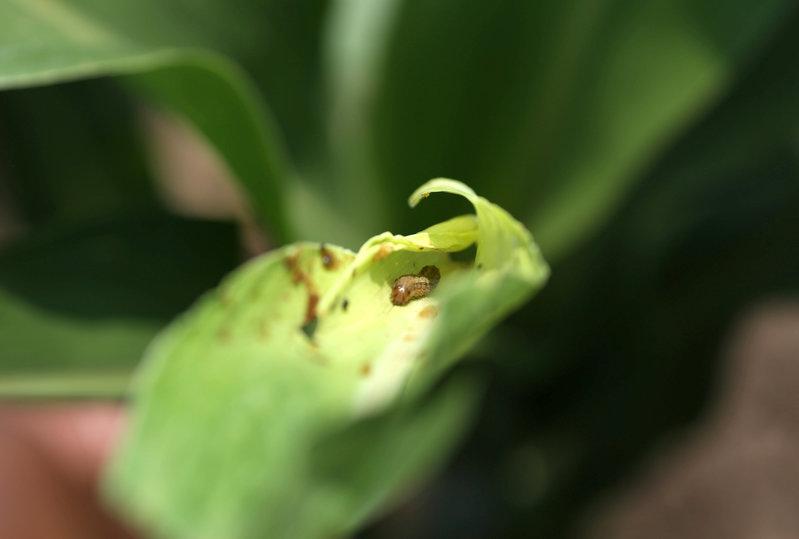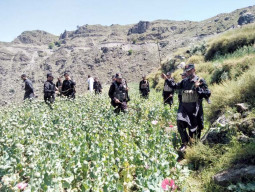
Despite their unassuming outlook, parthenium is a toxic weed which is aggressively colonizing parts of the capital and other parts of the country.
In the absence of adequate horticultural regulations, the alien, invasive, unwanted and harmful plant is free to grow.
“Though plant and animal quarantine acts are available in the country, they primarily exist to allow the Animal and Plant Health Inspection Service (APHIS) to regulate the import and interstate movement of nursery stock, and other plants that may carry pests and diseases that are harmful to agriculture,” stated Ministry of Climate Change (MoCC) Forests Inspector General Syed Mehmood Nasir as he lamented the freedom afforded to this toxic weed.
Talking to The Express Tribune, Nasir explained that these laws were created to control the spread of diseases only. The germination of an alien and invasive species of plants, however, was a wholly different matter.
One of the main propagators of this weed - which inhibits the growth of other native species in environments where it is introduced - are private nurseries.
Nasir said that these nurseries often import these invasive weeds as seeds thinking only about how they will look, rather than considering the impact they will have on the local environment.
Most of the time nursery owners stuff these lethal weeds into bouquets to increase their volume, he lamented.
Parthenium is an aggressive global annual herbaceous weed with no economic importance. This erect, ephemeral herb is known for its vigorous growth and high fertility, especially in warmer climates. It is a native of north-east Mexico and is endemic in America.
“Parthenium is a prolific weed belonging to Asteraceae family, producing thousands of small white capitula, each yielding five seeds upon reaching maturity. Within the past century it has found its way to Africa, Australia, Asia and Pacific Islands and has now become one of the world’s seven most devastating and hazardous weeds,” explained MoCC Biodiversity Director Naeem Ashraf Raja.
Weeds becoming a concern: UAF VC
This deadly weed, he said, is often spotted on abandoned plots, residential colonies around town, railway tracks, roads, drainage and irrigation canals.
It grows luxuriantly in established gardens, plantations and vegetable crops. Owing to its high fertility, a single plant can produce 10,000 to 15,000 viable seeds which can be dispersed and germinate to cover a large area.
This alien weed is believed to have been introduced into India as contaminants in PL-480 wheat (Public Law 480 passed in 1954) to give food grains to developing countries for eliminating starvation and malnutrition. It was imported from the USA in the 1950s.
It is now widely prevalent in Pakistan, growing over thousands of hectares of land.
Hoeing in orchards could save plants from mealybug attack: experts
”In 2001, the intrusive weed was found at some scattered locations in Islamabad besides other parts of Khyber -Pakhtunkhwa, Punjab and Azad Kashmir. Now, it has spread over a large area,” Raja said, adding that the weed is considered to be a cause of allergic respiratory problems such as contact dermatitis, mutagenicity in humans and livestock.
Crop production is also affected by it due to its aggressive dominance.
It can be eradicated by burning, chemical herbicides, eucalyptus oil and biological control by leaf-feeding beetle, stem-galling moth, stem-boring weevil and fungi. Each of these measures has been conducted with variable degrees of success in the country.
Around 20 years ago, the then ministry of environment, local government and rural development had prepared a report on the country’s biodiversity. The report reviewed the existing legislation on land, water, soil, air, forests, and oceans.
It revealed that biodiversity was not adequately addressed by legislation, rather were contrary to the provision of the conservation, sustainable use and equitable benefit sharing of biological resources.
The report stated that standards for industrial effluents were not fixed keeping in mind the diverse ecosystems of Pakistan, the forest and tree cutting acts focusing on certain species rather than the whole ecosystem. Even the implementation mechanism for forest and biodiversity were not effectively coordinated between all the provinces.
The quarantine laws aimed at restricting the import and export of diseases through the biological material and not through invasive species or genetically modified organisms.
Reports had highlighted that in terms of fisheries, legislation focused only on revenues for the state from marketable fish, and not on the aquatic ecosystem including plants and non-fish animals.
The reports said that the National Conservation Strategy (NCS), the Forestry Sector Master Plan (FSMP), BAP and the Forest Working Plans deal with biodiversity-related strategies and policies in Pakistan. Although these deal with biodiversity conservation, the issues were poorly understood at the time these policies and strategies were made. The NCS deals with biodiversity as a discipline that was a component of various subjects like wildlife, forestry and agriculture.
Moreover, biodiversity had been tackled in a non-integrated way that clearly shows lack of conceptual clarity. The forest working plans were prepared in isolation of wildlife planning or laws and had a specific objective of providing a sustainable yield of wood.
Sustainable forestry and Biodiversity had not been debated in the ministries of the federal or provincial departments that deal with forestry. However, the BAP is the first comprehensive attempt by Pakistan on contemporary issues of the CBD.
The biologists believe that the policies and programmes of food and agriculture, finance, commerce, science and technology besides of provincial departments including agriculture, livestock, forestry, wildlife and tourism are crucial to the conservation and sustainable use of biological resources.
Published in The Express Tribune, June 25th, 2018.



























1714024018-0/ModiLara-(1)1714024018-0-270x192.webp)









COMMENTS
Comments are moderated and generally will be posted if they are on-topic and not abusive.
For more information, please see our Comments FAQ